#mekosuchinae
Text



Isn't etymology fun? Look at all the fun we're having.
This isn't even the only croc who's name translates to "Crocodile Crocodile"
236 notes
·
View notes
Text
The last Baru (Crocodylia, Mekosuchinae): a new species of ‘cleaver‐headed crocodile’ from central Australia and the turnover of crocodylians during the Late Miocene in Australia
Published 24th September 2023
Description of a new large mekosuchine crocodylian ,Baru Ilywenpeny, based on various cranial material from the miocene of the Alcoota fauna in Australia.
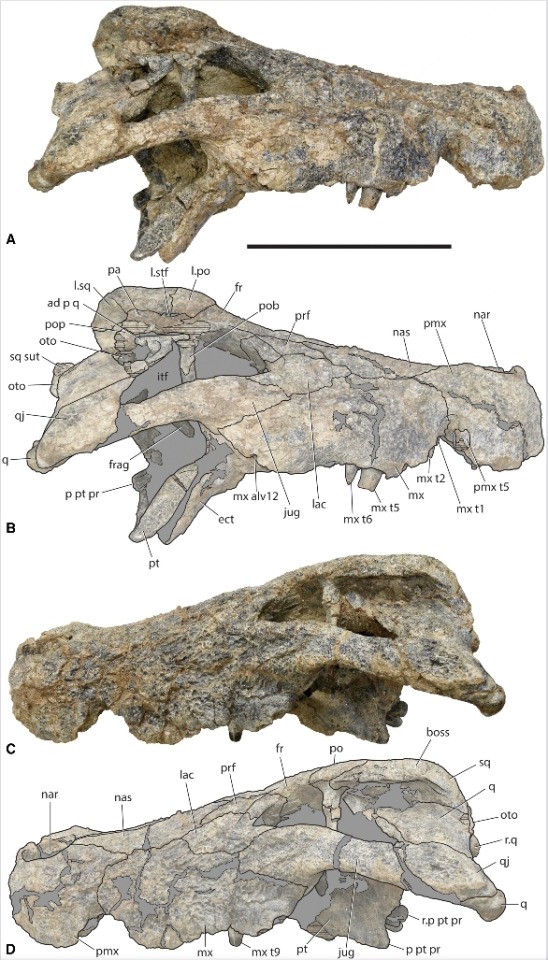
Baru Ilywenpeny holotype skull
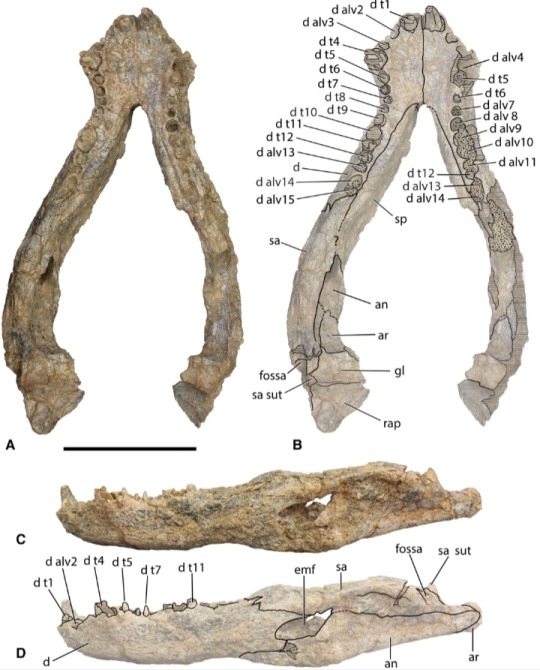

Baru Ilywenpeny paratype mandible and left mandibular

Baru Ilywenpeny holotype reconstructed skull
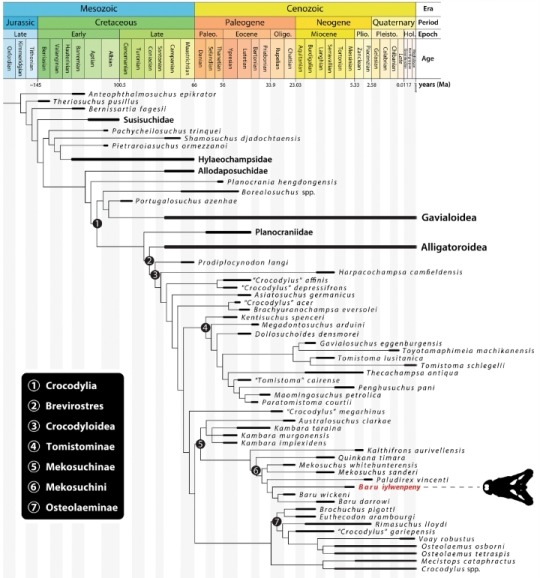
Baru Ilywenpeny phylogenetic results
Source:
https://onlinelibrary.wiley.com/journal/20562802
https://onlinelibrary.wiley.com/doi/full/10.1002/spp2.1523
2 notes
·
View notes
Photo

Island Weirdness #39 — Mekosuchus inexpectatus
Along with their weird giant birds, the islands of New Caledonia were also home to a small crocodilian unlike any alive today.
It was one of the last known members of a lineage of crocodiles known as the mekosuchines, which originated in Australia during the early Eocene about 50 million years ago and later island-hopped out into the South Pacific — mostly around the Coral Sea, but with some making it as far as New Zealand. By the start of the Holocene, about 12,000 years ago, they'd already declined and disappeared from the vast majority of their range, with only a few isolated island species remaining.
Named Mekosuchus inexpectatus, the New Caledonian mekosuchine was only about 2m long (6'6"), just slightly bigger than the modern dwarf crocodile. It was much more terrestrial than living crocs, spending most of its time on land, and it had teeth in the back of its jaws that were specialized for crushing, suggesting it mainly preyed on hard-shelled invertebrates such as snails and crabs.
Based on its limb anatomy it may also have been able to climb trees. Although this idea was ridiculed when it was originally suggested back in the 1990s, a more recent discovery has shown that modern crocs can actually climb trees too.

Like with many other Holocene island species, the extinction of Mekosuchus inexpectatus seems to be directly linked to the arrival of humans, who reached New Caledonia around 1500 BCE.
Bones in archaeological kitchen waste sites show that the settlers actively hunted and ate Mekosuchus, but dating of the last known remains is uncertain. The most generous estimate is actually as recent as about 300 CE, so much like Sylviornis these small land crocs may have persisted for some time before finally going extinct.
#science illustration#island weirdness 2019#paleontology#paleoart#palaeoblr#mekosuchus#mekosuchinae#crocodilia#crocodile#pseudosuchia#archosaur#art#insular dwarfism#new caledonia#holocene extinction#island weirdness 2: endemic boogaloo
296 notes
·
View notes
Note
Do you know any super gross super adorable domestic Spuhura fics? Like they’re too cute to even be real and so in love it’s ridiculous. Please because I am dying of thirst for such a thing over here.
first: you and I both, nonny!second: ok, I really, really, suck at remembering all the titles and links when people ask me these questions (it must be a side effect of having read SO MUCH stuff), and I usually remember all the things only after I hit the publish button because of course it works like that, but that said, here’s the ones I can think about right now (and you probably read most of them already.. lol)
order absolutely random:
Good-Night Rituals (ff.net) by @amazonpoodle
Thief by slipperystone
the little one-shots by ebonbird
the What We Will Find series by @psicygni may fit with what you are looking for too. As well as everything here
What it is like by Pat Foley (what fighting and making up with Spock is like. ^_^)
Accommodations, For The Love Of Poinsettias, A Little Night Music by Aashlee Elizabeth
The Bean Jar by @cgockel , also Overflow: Pon Farr 35 since we are at it because that’s the most positive, funny and cute representation of his pon farr
The Things We Carry and Daisy Petals by siskiyou
First thing when, and also What is this: Is it too much to ask (it’s angsty but has elements of fluffiness domesticity IMO) by @isanybodygettingthis (check her blog too, she posted some quite good fluffy and hot pieces as well some fanfiction recs)
you should read everything by @majestrixstormbringer
the stories by SpockLikesCats
Like the Stars, Like Your Destiny by anodyna has elements of that too if I remember well.
Control by brontelover
The Logic of Pajamas by jncar
Baby Book by nerdielady is a baby-S/U ff and so fluffy and adorable it may test your endurance of that kind of thing (also check her page she has other fluffy ff)
Touching and Touched by @linstock-oz
All I Want for Christmas (the inevitable, kids mistake Spock for an elf fic lol!) by Lurkch
Nightly Reasons by DealingDearie
Dirty Talk by Gamebird
Comforts of Home by TrueAwesomeSauce has some S/U fluff
Of Kleenex and Vulcans by Scholar’s Callous (Nyota is sick, nuff said)
and none of the benefits ,a suitable arrangement by mekosuchinae (thanks to @tumbleweedt for the suggestions)
anyone has more ff to suggest that I (surely) missed/forgot/didn’t read?
164 notes
·
View notes
Text
Trovato in Australia il fossile di un enorme coccodrillo del Pliocene
Trovato in Australia il fossile di un enorme coccodrillo del Pliocene
Paludirex vincenti appartiene ai Mekosuchinae, una sottofamiglia estinta di coccodrilli dell’Australia e del Sud Pacifico.
Un nuovo genere e una nuova specie di coccodrillo preistorico, Paludirex vincenti, è stato identificato da fossili rinvenuti nel Queensland, Australia.
Paludirex vincenti ha vagato per il nostro pianeta durante l’epoca pliocenica, tra i 5 e i 2,5 milioni di anni…

View On WordPress
0 notes
Link
Author: mekosuchinae
Fandom: Star Trek
Rating: Teen
Pairing: Gen
Summary: This was why he was captain, and also awesome.
Words: 1,075
0 notes
Text
The NEW Ultrastenos and its Ironic History
So those that have been keeping up with my posts on mekosuchines might recall the name Ultrastenos, as I've talked about this genus back in August of last year. If you've read that post you might also remember how I highlight at multiple points that a lot of the info was tentative on the basis that Ultrastenos was highly incomplete and that close relatives awaited description.
You may also remember "Baru" huberi, a small mekosuchine that lived roughly around the same time, clearly distinct from Baru yet at that point still unnamed. Oh, how I wished for the former to get more material and for the latter to recieve a proper genus assignment.
My now outdated reconstructions for "Baru" huberi (the small one in the left image) and Ultrastenos (right image)

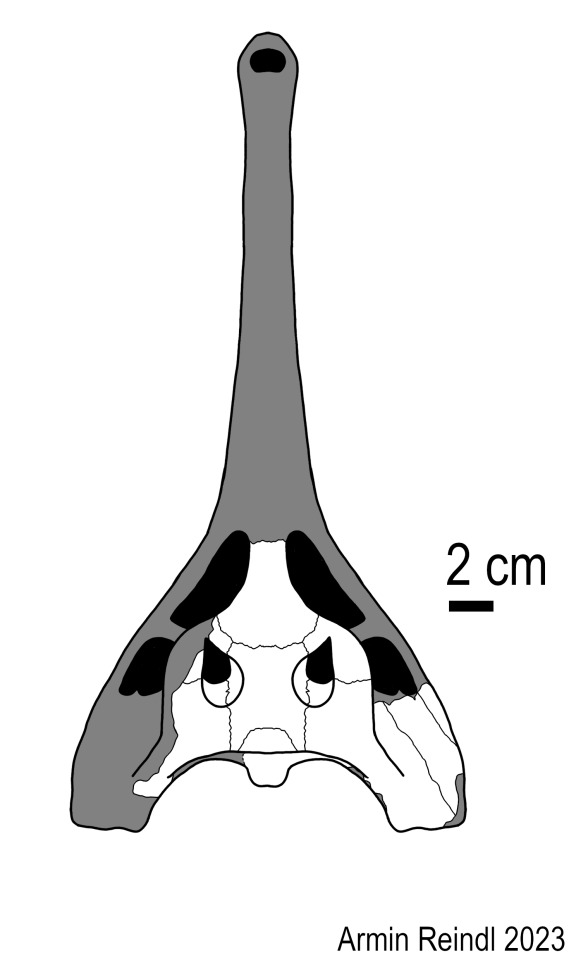
And then the monkey's paw curled.
As it turns out....they are the same damn animal.
Now, back when "Baru" huberi was described, Willis also named a bunch of other mekosuchines from the same locality (the White Hunter Site of the Riversleigh WHA) and described even more material that remained unnamed, including the White Hunter Cranial Form 1. Now, when Ultrastenos was named in 2016, the type material was from the Low Lion Site (also Riversleigh), but importantly, the skull tables identified as WHCF1 were also assigned to the genus (and were the basis for my reconstruction).
Well, re-examination has shown that the WHCF1 and the holotype of "Baru" huberi aren't just a single species.....THEY ARE A SINGLE INDIVIDUAL.
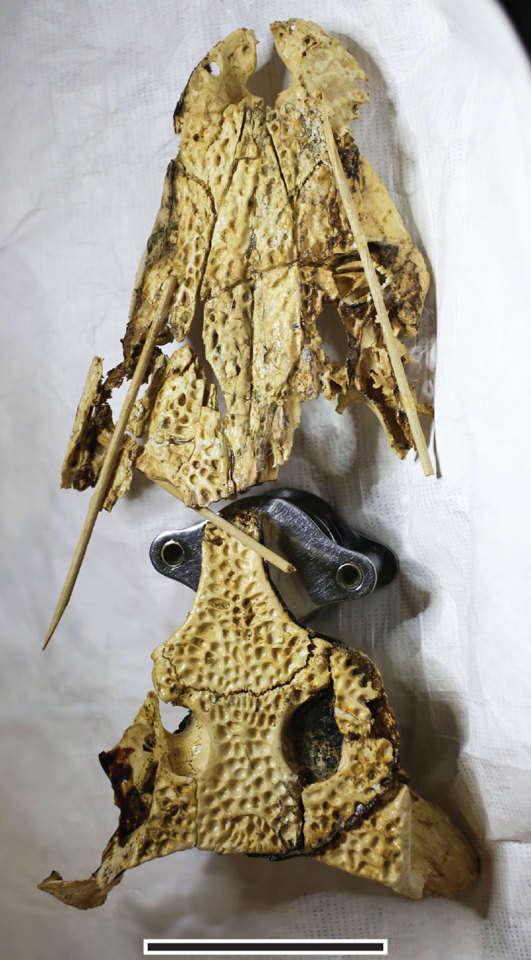
Given the fact that the assignment of the skull table to the Low Lion Ultrastenos material still holds up, this means that Ultrastenos willisi and "Baru" huberi are a single taxon. Which consequently requires some reshuffling of the names.
"Baru" huberi was named first, so the species name takes priority and continues being used. However, since it was never given a genus name, Ultrastenos does stay valid. Except now it's called Ultrastenos huberi, not Ultrastenos willisi.
A name that has aged like milk. Back in 2016 it was proposed that Ultrastenos had a very narrow snout (thus the name), so now that we know that the rostrum was flat and mesorostrine, the name really is just wrong.
So next up, lets examine what went wrong.
As I said before, Ultrastenos was fragmentary, so that certainly played a big part in it. But the team in charge of describing the animal still cited several lines of thinking to support their interpretation, most of which are now thoroughly debunked.
As an example, the lower jaw was rather shallow, however while this was initially taken as evidence for longirostry, the 2024 paper states that this only an argument against altirostry (a deep skull), not against a more generalized condition. The teeth were also initially used as evidence, citing their homodont condition (the teeth looked uniform), HOWEVER, the problem in that was that there were only a few teeth present, all of which notably do not bear any resemblance to the needle-like teeth seen in other long-snouted taxa. Another important clue initially taken to mean longirostry was the orientation of the quadrate area and the seemingly sudden constriction of the lower jaw. But the quadrate area was not found in articulation and would support a generalized skull form if simply rotated a little, while the constriction of the mandible appears to at least be partially exaggerated by preservation.
Of course, the fact that we now have proper material of the snout makes the interpretation of a generalized skull shape a lot more solid.
Image 1: The left and right halves of the mandible of Ultrastenos compared to that of Baru iylwenpeny (D), note how the right half is a lot more straight.
Image 2: The initial reconstruction of the quadrate area of Ultrastenos compared to one that is slightly rotated
Image 3: The revamped skull reconstruction by Yates and Stein

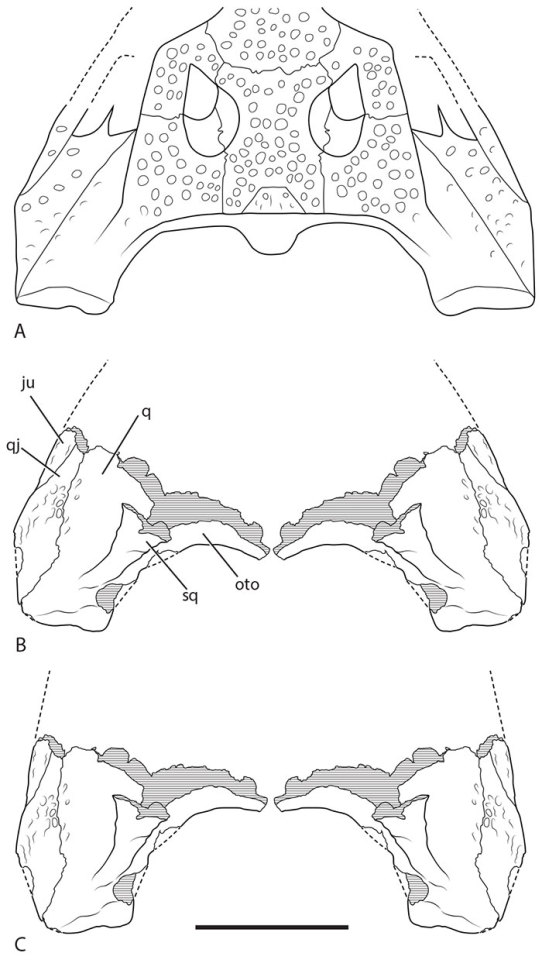
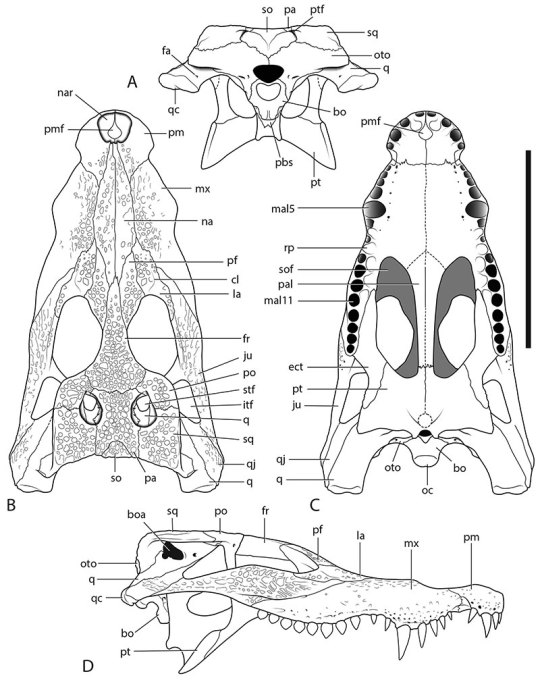
The size of the animal does stay relatively unaffected by these new discoveries. "Baru" huberi has been estimated at only around 1.5 meters in length and my own scaling of Ultrastenos got up to 2 meters, which seems to be in line with what is still assumed for this animal. So among aquatic mekosuchines, its still rather small.
There are however some interesting implications for mekosuchines at large. Now that we no longer have a longirostrine member of this family, one has to wonder, why is that?
Well, there might be several reasons.
It could be that the types of environments that were present in Cenozoic Australia simply didn't support such animals. Even in the type description, its been noted that the Riversleigh isn't exactly known for its fish remains, leading to the idea that Ultrastenos might have gone for other small vertebrates like frogs. Hell, the ecology of Baru might suggest that the reason that this genus was so robust might tie to the fact that the local bodies of water just weren't deep enough to allow the typical crocodilian grab-and-drown tactic.
Competition might have been another factor. In environments that may have been more suitable for such morphology, mekosuchines might have been beaten to the punch by other types of crocodilians. Harpacochampsa for example, tho originally thought to be a mekosuchine, is now more often regarded as either an unrelated crocodile or a gharial and its very possible that it filling the nische of a longirostrine simply meant that mekosuchines didn't have the opportunity to expand into that space. Same goes for Gunggamarandu in the Pliocene and Pleistocene and Freshwater Crocodiles from the Pleistocene onwards. (Tho it should be noted that both Harpacochampsa and Gunggamarandu are so fragmentary that their snout shape is technically unknown).
Images: Gunggamarandu (Eleanor Pease), Harpacochampsa (ArtbyJRC) and Freshies (Antoni Camozzato) might have been key factors in why mekosuchines never evolved slender snouts.
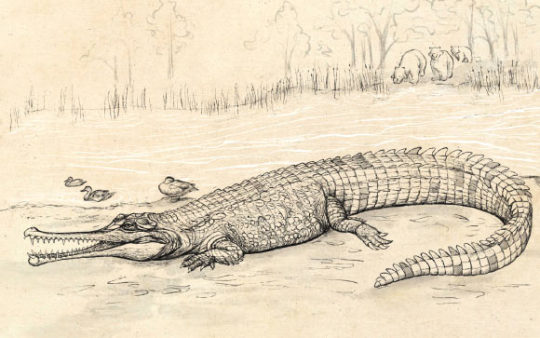
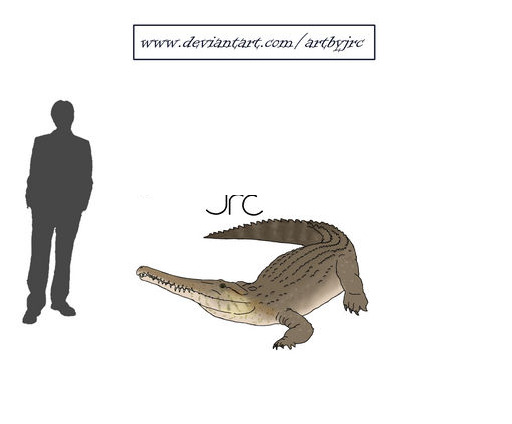
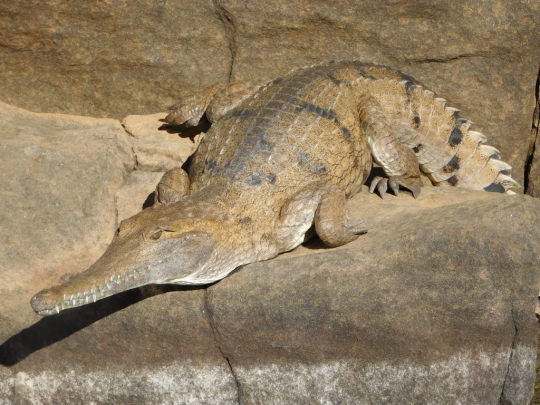
Finally, its also possible that something in the growth of mekosuchines simply prevents them from evolving longirostrine skulls, which Yates and Stein liken to alligatoroids (notably the closest alligatoroids got to traditional longirostry as seen in gharials is the Rio Apaporis Caiman, and even that one is closer to some extant crocodiles in its morphology).
Whatever the case, I for one mourn the loss of our long-snouted Ultrastenos. Tho as a note for any paleoartists, there is not a single illustration of this new interpretation since nobody ever drew "Baru" huberi either. Wink wink nudge nudge
Links:
https://en.wikipedia.org/wiki/Ultrasteno
Ultrastenos revised (palaeo-electronica.org)
#long post#harpacochampsa#ultrastenos#baru huberi#mekosuchinae#gunggamarandu#oligocene#riversleigh#paleontology#palaeoblr#croc#crocodile#crocodilia#prehistory#cenozoic
46 notes
·
View notes
Text
Mekosuchus
My recent-most Wikipedia deep dive was in equal parts enlightening and frustrating and it concerned no other than Mekosuchus, everyones favourite heartbreaker of a recently extinct crocodile.
For those unfamiliar, let me give you some footnotes before getting into the nitty gritty. Mekosuchus is, or was, a genus of terrestrial (NOT ARBOREAL) dwarf crocodile from Australasia, first appearing during the Late Oligocene. They were small, how small we don't precisely know but its generally estimated that adults would be in the 1-2 meter range (so about 3 to 6 feet I believe?). The heartbreaking part? The last confirmed Mekosuchus died out only 3.000 years ago, and some publications even suggest they could have stuck around until just 1.700 years ago. Yeah, we got REALLY close.
Art by yours truly, I'll explain the massive difference down below, just be patient.

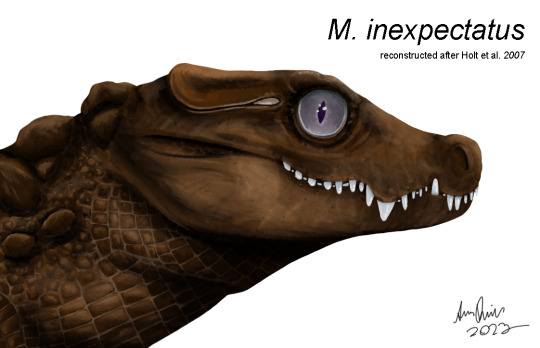
But lets get some of the basics out of the way. Mekosuchus was a small mekosuchine crocodilian and currently, four species are recognized. Mekosuchus whitehunterensis is the oldest from the Oligocene/Miocene of mainland Australia, immediately succeeded by M. sanderi during the Miocene. Both these species were described as having had blade-like posterior teeth (at the back of the jaw) and both coexisted with a ton of other crocs, including Baru, Quinkana and some bizarre ones like Ultrastenos.
After a bizarre break in the fossil record, Mekosuchus shows up again during the Holocene on the islands of New Caledonia and Vanuatu, ironically mirroring the meiolaniid turtles I talked about previously. Fossils are securely dated to about 3.000 years ago, but Balouet and Buffetaut also suggested that some of the younger remains may only be 1.720 years old, overlapping with human settlements. But this isn't accepted by everyone. Regardless, these species differ from their older cousins by lacking the blade-like teeth, instead going for crushing dentition.
Art by artbyjrc and Kahless28
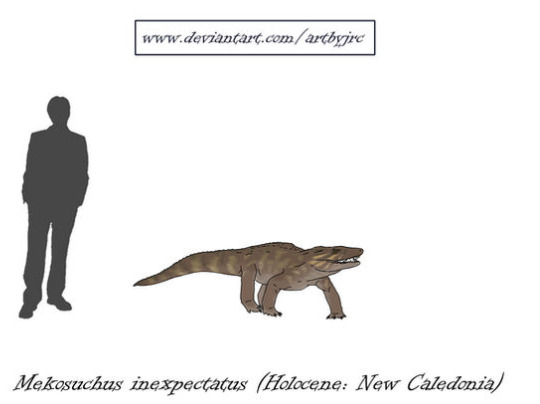

With such different teeth comes different ecology, of course. A 2015 study suggests that the neck vertebrae of M. whitehunterensis were well adapted to rapid stresses, specifically caused by side-to-side movement of the head. It is thus speculated that they shook their heads to strip meat from carcasses, rather than performing the iconic death roll (as that might hurt the animal on land).
M. inexpectatus meanwhile was seemingly better adapted at crushing hard-shelld things, crabs, insects, maybe snails even. Holt and colleagues suggest that it might have lived much like a modern dwarf crocodile, spending its time in river streams and coming out at night to forage.
Dwarf crocodile via the San Diego Zoo and Mekosuchus illustrated by my friend BatmanelVisigodo


Both however are thought to be terrestrial, having short, altirostral skulls, big eyes and nares that face sideways, not upwards as in semi-aquatic crocodilians. They were however NOT ARBOREAL. Yes I know I know, its a bummer. To those unaware, a commonly cited missconception is that Mekosuchus was a tree-dweller, which was originally suggested by Paul Willis in the 1990s. However, this was more of an off-hand comment at the time that certain people (including me in the past) have run with, causing it to spread and be almost considered fact by some. Hell, it says a lot when Mekosuchus, in many circles, is thought of as "that tree croc".
However, not only was Willis suggestion based on the now outdated notion that monitor lizards weren't around at the same time, later authors also note that the toes of Mekosuchus really don't show any adaptations to climbing specifically. So alas, it would seem that this was only a myth. But don't worry too much, sometimes crocs climb regardless, just not vertically up a tree.
Mekosuchus artwork by Manusuchus
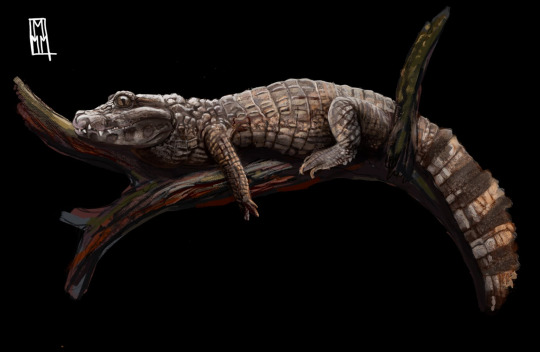

Now at the beginning I teased that there's a reason why my images for M. whitehunterensis and M. inexpectatus look so different. Well its kind of painful really. Despite being known for about 30 years now, with 300+ bones known from New Caledonia alone, Mekosuchus is incredibly poorly studied. The original description only figured around half a dozen bones and while the next three species were all named in the span of just 5 years, they are all incredibly fragmentary. And then, just after another expedition collected more bones....things went silent.
The last 20 years saw the publication of only a single paper extensively dealing with Mekosuchus itself, with two skull reconstructions coming out in less detailed sources.
The first is Holt et al. 2007, a powerpoint presentation from a paleontological conference. The presentation made some fascinating claims and even provided a reconstruction of the skull, but sadly. Nothing ever came of it, the research was never formally published and the lead author has since then changed fields into Astronomy. Actually had a nice talk with him earlier today.
Then there's Scanlon 2014, which offers even less. In the book Carnivores of Australia: past, present and future, Scanlon briefly touches upon mekosuchines, featuring a new composite reconstruction of M. whitehunterensis. However, this is not elaborated on in the text, despite the drastic differences to how M. inexpectatus has been reconstructed before. So we are left with two very different appearances. Are they simply really different looking species? Is one interpretation faulty? Should Mekosuchus be split? Who knows, might be a while until we figure it out. But until then, here's the two together, one looking much like a dwarf crocodilian, the other more like a sebecid. An interesting contrast for sure.

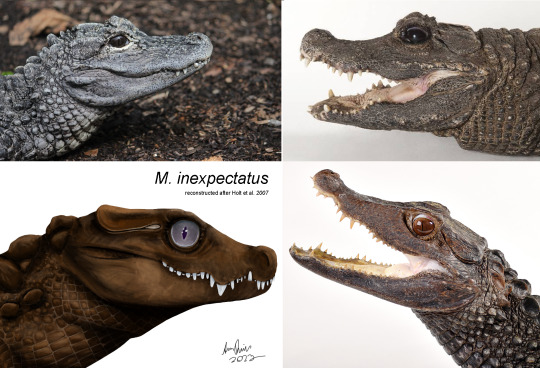
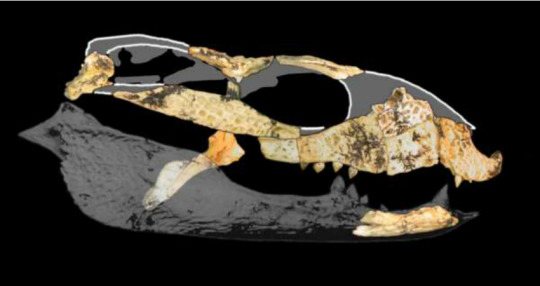
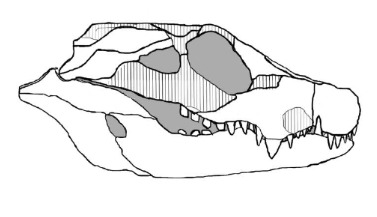
As per usual, this research was done as part of me doing a major haul of a Wikipedia page which you can read here Mekosuchus - Wikipedia. It's been an interesting, if a little frustrating task, but it was fun properly reading up on this animal and putting this information out there for people that don't wanna dig through 30 years of literature (including one paper in French).
Hopefully I suceeded, at least the page is a bit bulkier now.
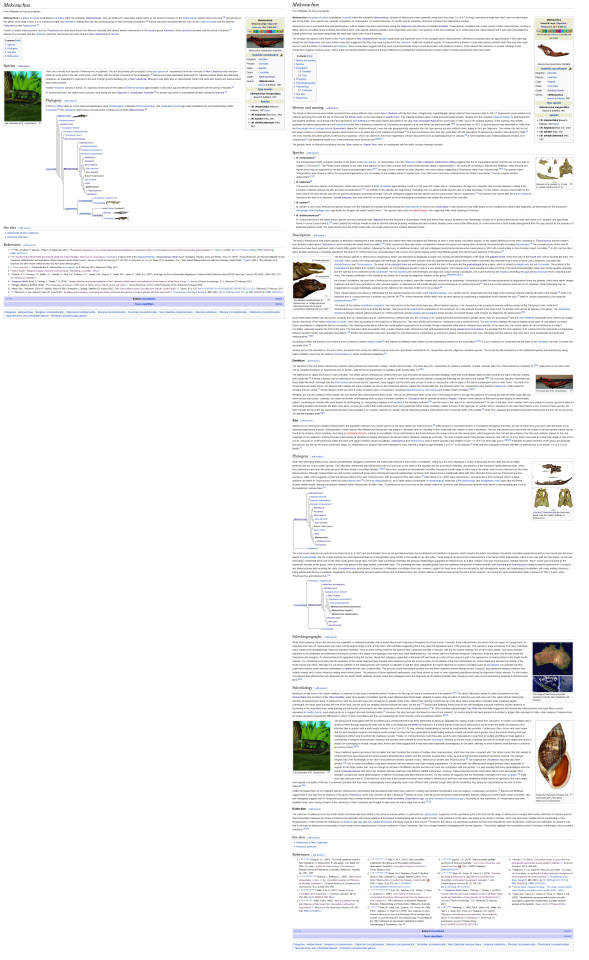
#wikipedia editing#palaeoblr#paleontology#prehistory#long post#crocodile#mekosuchus#land crocodile#mekosuchinae#new caledonia#extinction#paleo#science
182 notes
·
View notes
Text
Baru iylwenpeny: The Last Baru
Happy to announce that there's just been a major new publication for mekosuchines. The Alcoota Baru, which I briefly touched upon in my post on the genus, has finally been named.
The new name, Baru iylwenpeny (pronounced eel-OON-bin-yah), derives from the Eastern Anmatyerr dialect (part of the Arrernte language) and means "good at hunting". A name that seems quite fitting when you look at the skull.
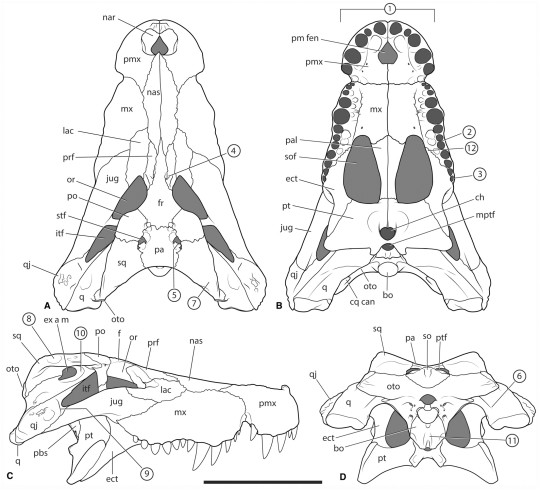
As a reminder, this animal stems from the Alcoota Fossil Site in Australia and dates to the Late Miocene, making it the youngest of the three recognized Baru species.
Previously this species was already referred to as being "the most robust Baru" and they weren't kidding. This thing looks more like something out of the Cretaceous than an animal that lived a mere 8 million years ago.
The morphology is interesting in many ways. Many of the ridges that are so prominent in Baru wickeni and less developed in Baru darrowi are absent. The seventh and eight tooth are so close they theres basically no space. Instead of four teeth like other Baru it has five in each premaxilla and the nasals reach the nares, like in Baru wickeni but unlike in Baru darrowi. The teeth also show the same small serrations as Baru darrowi and, unlike either of the other species, the jaws appear much less wavy not because they are but because the first festoon of the maxilla is followed up by a second one so developed it makes the first look almost flat.
It's a fascinating mosaic of characters that makes its relation to the other species a puzzling question. You'd think that the ridges for instance point at it being derived? After all wouldn't it make sense? Baru wickeni had the most developed rigdes, Baru darrowi smaller ones and Baru iylwenpeny none. Plus, the teeth of Baru wickeni are smooth unlike those of later forms. Yet at the same time....
The fact that it has five teeth instead of four and the fact that the nasals reach the nares are both ancestral traits, so you'd expect it to be closer to the base.
Left: Baru wickeni
Right: Baru darrowi
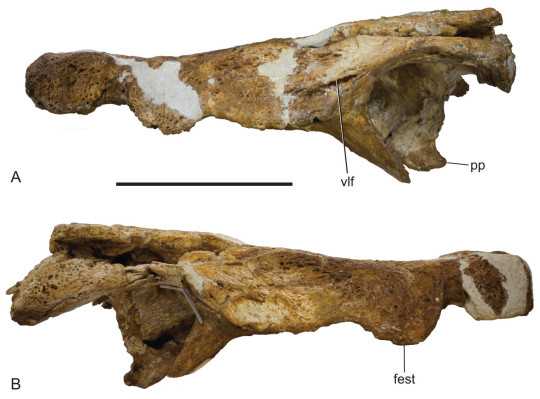
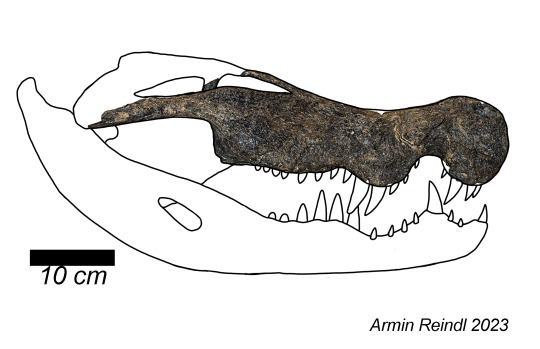
Well, while I think this isn't going to be the final place of this species among Baru, the most recent phylogenetic analysis suggests that Baru iylwenpeny was weirdly enough the basalmost species. Which means that it must have split from the other two species at the latest during the Late Oligocene and outlived the both of them without us ever knowing.
The paper also discusses how these animals may have gone extinct. If you look back at Kalthifrons, you might remember how I mentioned that mekosuchines kinda had a drop in diversity when transitioning from the Miocene to Pliocene. While the new paper avoids calling this a drop in diversity, it does highlight that there certainly was a turnover in fauna.
The reason is an old enemy of mekosuchines. Climate.
Yates and colleagues suggest that Australia was hit by an especially nasty dry period at the end of the Miocene, severe enough to drive Baru to its death but not severe enough to whipe out all mekosuchines. And after Baru was gone, Kalthifrons and Paludirex moved into the open niche.
There's also a final little piece of information that's not focused on yet really fascinating. Baru iylwenpeny had a friend. At least one other croc lived at the Alcoota site during the Late Miocene and tho it hasn't been studied in full yet, one thing is apparently known. It was a relative to the Bullock Creek taxon that coexisted with Baru darrowi and a relative to "Baru" huberi, the small croc that coexisted with Baru wickeni. This grouping has yet to be given a name, but its fascinating to me that each Baru species seemingly coexisted with a much smaller mekosuchine. Alas, like Baru this lineage seems to have fallen victim to climate change.
Baru wickeni and "Baru" huberi, in truth an unnamed genus.
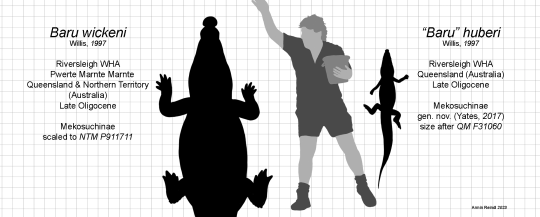
The paper is accessible here for those that wan't to dive deeper into the matter. I'll also be working on an updated size chart, this time featuring all three species of Baru, tho I can already tell you that despite being more robust its surprisingly not that much larger.
The last Baru (Crocodylia, Mekosuchinae): a new species of ‘cleaver‐headed crocodile’ from central Australia and the turnover of crocodylians during the Late Miocene in Australia (wiley.com)
#baru#baru iylwenpeny#alcoota baru#alcoota fossil site#miocene#paleontology#palaeoblr#crocs#crocodile#mekosuchinae#paleontology news#prehistory
95 notes
·
View notes
Text
Kalthifrons and the Fall of Mekosuchines
The penultimate singular mekosuchine I'll talk about here is Kalthifrons, one of the more obscure members of this clade. After all, Kalthifrons was named only in 2017 and unlike some other animals like Ultrastenos, it does not stand out as much morphologically. But I still wanna take a moment to talk about this medium-sized Pliocene croc, its potential fate and the implications for its relatives.
Left: The skull of Kalthifrons (Ristevski et al. 2023)
Right: A reconstruction of how the skull may have looked like intact


In many respects Kalthifrons looks very typical for a crocodilian, with a triangular head, rounded snout and eyes that face upwards. There are some interesting factors to mention, at least imo, and one thing thats sorta unknown. Starting with the unknown, what we aren't sure about is how deep the skull is. Sure the skull of Kalthifrons looks very intact in top view, but when looking at it from the side its about as flat as a sheet of paper. So we can't exactly tell how deep the skull would be. Maybe it was not much different from a modern croc...or maybe it was comparable to Baru the cleaver-headed crocodile. We simply don't know. The other two interesting things about its anatomy are more subtle. For one, the tip of the snout is comparably narrow. Now generally, if you look at mekosuchines the premaxilla and external nares tend to be wider than long, even in Australosuchus, but in Kalthifrons they are longer than wide. And then there's the frontal. The name Kalthifrons derives from the Latin word for forehead and the Dieri word for spear. The reason why is that the frontal bone, which covers the forehead, has an exceptionally long spear-like process at the front. Sure such a process is also found in other crocs, but in Kalthifrons it makes up 64% of this bones entire length.
A hypothetical reconstruction showing the size of Kalthifrons, which may have been around 3.4 meters.

With a length of possibly up to 3.4 meters and a triangular skull, Kalthifrons was probably a fairly generalist hunter. Fossils of Kalthifrons are known from a single place, the Golden Fleece Locality along the shores of Lake Palankarinna in the Lake Eyre basin, South Australia. Now this locality primarily yields two things. Croc fossils and turtles. Based on this and certain minerals in the sands of this locality, it has been suggested that the Golden Fleece Locality once housed a waterhole that dried up, leading to the deaths of its inhabitants.
The death of Kalthifrons as illustrated by Joschua Knüppe.
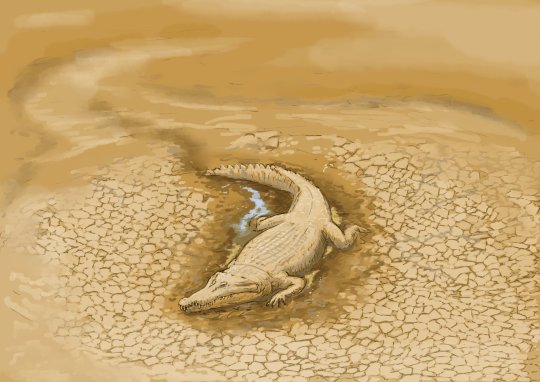
Which leads us to a bit of discussion regarding the general state of mekosuchines during the time of Kalthifrons. Now if you have read my previous posts on mekosuchines, you'll notice one thing. Most species native to continental Australia were around during the Oligocene to Miocene. Australosuchus, Baru, Ultrastenos, "Baru" huberi, Trilophosuchus and the continental Mekosuchus species. After the Miocene, continental species become rarer. Really you got Paludirex, Kalthifrons and Quinkana. And even they wouldn't stick around for much longer, with the last mekosuchines of Australia going extinct at the end of the Pleistocene.
So obviously mekosuchines experienced a drastic fall in diversity towards the end of the Miocene, clinging on for a few more million years before disappearing forever. But there's another thing that happened around this time. Modern crocodiles showed up. Contrary to popular belief, today's crocodiles of Australia are relatively recent arrivals. Freshwater crocodiles only lived there since the Pleistocene and saltwater crocodiles were likely even more recent, with both of them having evolved from different ancestors and arrived in Australia independently. But there's at least one more species of Crocodylus. The as of yet unnamed Tirari Desert Crocodile is known from remains that date to strata slightly more recent than that of Kalthifrons, displaying similar generalized anatomy. Like freshies and salties, the Tirari Crocodile arrived on its own, with phylogenetics indicating that its closest relatives were the palaeoafrican crocodiles like Crocodylus thorbjarnarsoni (a giant that grew up to 8 meters long).
Crocodylus species of Australia
Top left: The freshwater crocodile (Ristevski et al. 2023)
Bottom left: The saltwater crocodile (Ristevski et al. 2023)
Right: Stratigraphy of the Lake Eyre Basin and successions of local crocodilians (Yates and Pledge 2017)

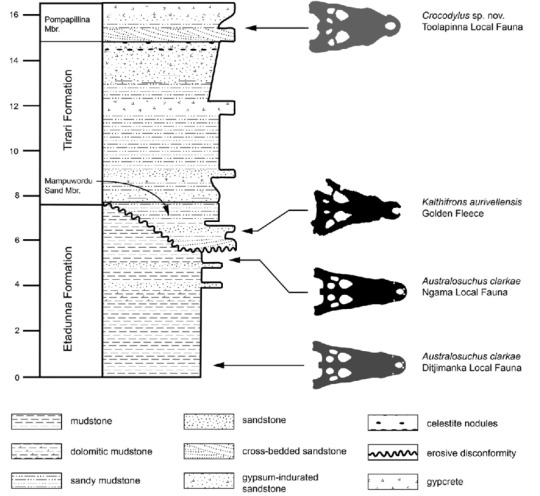
Did Crocodylus drive Kalthifrons to extinction? Well, maybe? Yates and Pledge discuss this possibility in the description of Kalthifrons, suggesting that theres some supporting pieces of information for this hypothesis. Not only does the arrival of the Tirari crocodile match up nicely with the disappearance of Kalthifrons, but they both share very similar anatomy. And conventional wisdom suggests that two crocs of the same morphotype don't really coexist in the same habitats.
But there's also points against that which aren't as openly discussed. Namely, the lack of material. Sure we have Kalthifrons in the older Mampuwordu Sand Member and the Tirari Crocodile in the younger Pompapillina Member, but remember. We only have that one Kalthifrons individual. We further know little about their habitat preferences. Sure conventional wisdom suggests crocs with similar morphology don't coexist, but that doesn't mean they don't overlap. Some species may very well be separated by the specific habitat they prefer. Slow open water, fast moving streams. Finally, is replacement necessarily the only answer? Not really. It has been deduced that Kalthifrons died in a drought and aridification is regarded as one of the main drivers of Australian megafauna extinction, as touched on in my summary of Paludirex. Maybe that's it? Kalthifrons was driven to extinction when environmental conditions grew too harsh, with Crocodylus entering the newly opened niche. This may parallel what happened in Miocene Africa, when rainforests disappeared osteolaemine crocodiles likely gave way to Crocodylus, which was better suited to the dryer climate.
Whatever the case, Kalthifrons is one of the most recent mainland mekosuchines and thus may be critical for us to determine what happened during this part of Australia's history. So sure it might not be flashy, but it's still an important little guy.
#mekosuchinae#kalthifrons#palaeoblr#prehistory#paleontology#pliocene#australia#croc#crocodilia#extinct#extinction#long post
90 notes
·
View notes
Text
Paludirex: Life of the Swamp King
Having gotten the long taxonomic history of Pallimnarchus and Paludirex out of the way (see here), lets talk more about the animal itself.
As far as we know at this point in time, Paludirex was the last of the large semi-aquatic mekosuchines and the largest members of this group had ever gotten. Whereas the cleaver-headed Baru dominated the waterways of the Oligocene and Miocene, Paludirex lived from the Pliocene and Pleistocene. There is some division between the species tho as it appears. Given the ambiguity around the origin of some Paludirex vincenti specimens, this species is currently only known from the Pliocene, whereas Paludirex gracilis is currently only known from the Pleistocene. There may also be a third species from the same region as Paludirex vincenti.
Comparisson between Paludirex gracilis (left) and Paludirex vincenti (right)

Anatomically, Paludirex has a pretty easily recognizable animal. Unlike Baru, with its short, triangular skull, Paludirex had a head that was almost rectangular when viewed from above, about half as wide as long and comparably flat. Mind you the skull can still be pretty deep, especially in Paludirex vincenti, but the proportions still highlight how wide it is most of all. In both robustness and skull width, Paludirex far exceeds what is known in modern saltwater crocodiles, which likely fill a similar niche.
Left: Skull reconstruction of Paludirex vincenti.
Right: Life reconstruction of Paludirex (Nellie Pease)


As said before, Paludirex represents the biggest mekosuchine. At a minimum length of 4 meters, it already rivals many of today's crocodiles and Baru, and that's just the smaller ones. Large individuals of Paludirex vincenti probably got much larger, 5 meters and more further drawing parallels to todays salties.
A size comparisson between Steve Irwin and both species of Paludirex
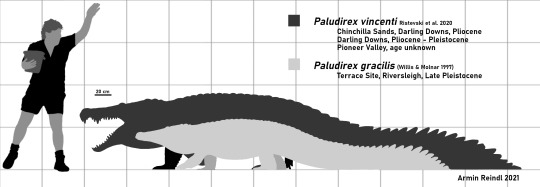
Now while the description is pretty sound on account of recent work by Ristevski and co., the ecology is a different matter. A lot of work was published back when Pallimnarchus was still a thing, so trying to separate what and what isn't applicable these days is a bit of a challenge.
On the most simple level, Paludirex was a generalist semi-aquatic ambush hunter. It's skull, tho incredibly robust and wide, shows no peculiar adaptations like long slender jaws so its obviously not a specialist. It's semi-aquatic because the nostrils and eyes face up so that they would peer out from the water while the rest of the body remained submerged. And these last two together basically suggest ambush-hunting.
Willis and Molnar also made comparissons between Paludirex skulls (or rather skulls now recognized as such) and Mugger crocodiles. All in all this suggests that its diet could have ranged from turtles to aquatic birds to large mammals (so the typical croc range really). They also infer that it may have had similar habitat preferences, being found in marshes, swamps, rivers, lakes, anywhere theres freshwater really. One exception may be that some researchers have argued that Paludirex was avoiding saltwater and brackish water, which eventually could have factored into its extinction once inland waterways in Queensland dissappeared.
Top: Eastern Sahul megafauna, the foreground features Paludirex about to ambush a giant kangaroo (Ryan Bargiel, Vlad Konstantinov, Andrey Atuchin & Scott Hocknull)
Bottom left: Paludirex vincenti (Diego Ortega Anatol)
Bottom right: An unforunate Paludirex being attacked by a marsupial lion (Joschua Knüppe)

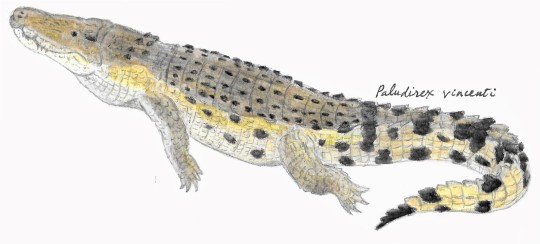

As with many crocs, its pretty likely that individuals were hostile towards each other at certain times, perhaps during territorial disputes or in the mating season. Now this one's a bit of a more ambiguous one regarding the assignment of the fossils. Fossils of leg material show clear bite marks, HOWEVER, the fossils were assigned to Pallimnarchus purely on the basis that they don't appear to have belonged to a terrestrial animal (as often inferred for Quinkana) nor to a modern croc. Based on this, the material was assumed to have been that of Pallimnarchus without much else to back it up. Now that Pallimnarchus is no more, it is reasonable to assume that it may be Paludirex but then again, it could also be an entirely different animal. Only way to tell would be to find Paludirex fossils with leg fossils attached.
This does bring up the interesting discussion, what crocs did coexist with Paludirex? Well there's a couple. As just mentioned, there's Quinkana, which I'll research more in depth later, but for now it's commonly assumed to be more terrestrial than other mekosuchines. There's the Darling Downs form, which lived around the same time as Paludirex vincenti in Queensland and may be a third species of this taxon. Gunggamarandu is another animal from this region, tho much as with Paludirex its not entirely clear if its Pliocene or Pleistocene. More certain is the fact that during the Pleiostocene, Paludirex gracilis coexisted with freshwater crocodiles in the Riversleigh WHA. Finally, there's indetermined species of crocodiles that date as far back as the Pliocene. Historically, they've been regarded as salties, but more recently it's though that they were a different species entirely and that salties only moved in recently, possibly after Paludirex went extinct and the niche of large semi-aquatic predator was free.
Top left: Quinkana faces off against Megalania (Hodari Nundu)
Top right: A freshwater crocodile running (Brandon Sideleau)
Bottom: Gunggamarandu, a relative of today's gharials (Eleanor Pease)


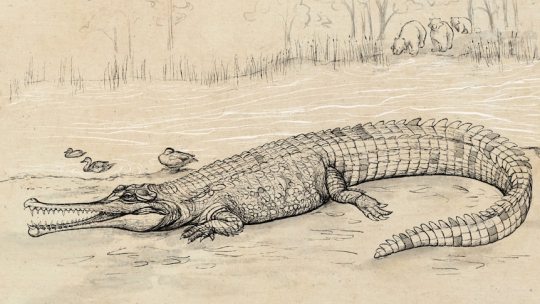
By this point I've basically already given away the reason why Paludirex is no more. With mekosuchines already taking a massive hit during the late Miocene, the group was not at its peak when Paludirex came around. And things were not getting any better as Australia grew more and more arid, river systems disappearing, freshwater drying up and the habitat of these animals shrinking bit by bit. Paludirex, presumably staying clear of coastal waters, was hit hard by these events and eventually it was just too much. And once it was out, saltwater crocodiles moved in, leading into the modern day.
#paludirex#pallimnarchus#palaeoblr#pliocene#pleistocene#australia#paleontology#prehistory#crocodile#croc#crocodilia#mekosuchinae#gunggamarandu#paludirex vincenti#paludirex gracilis#quinkana
117 notes
·
View notes
Text
Baru: The Cleaver-Headed Crocodile
Ok back on my croc stuff, today discussing Baru. Like most the other crocs I've been talking about, Baru was a mekosuchine, a member of an endemic radiation of crocodilian native to Australasia.
Baru is easily among the largest of this group and among the most robust, with massive curved teeth and almost inflated looking jaws.
Left my interpretation of Baru darrowi, right the illustration by Willis et al. from 1990.
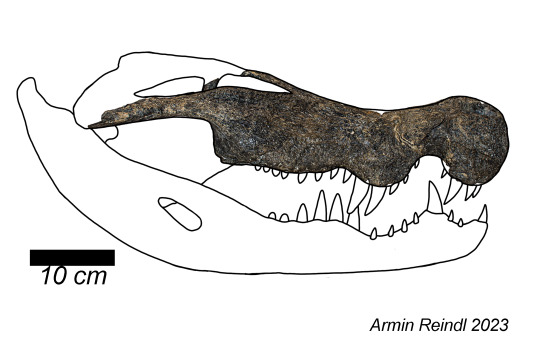

My reconstruction differs subtly in some regards, obviously the jaw material shown is from Ristevski et al. 2023 and elements of the posterior skull are based on the older Baru wickeni. My mandible also turned out slightly different, tho the quality of the images in the original description is not great so that is not guaranteed.
Anyhow, this head likely sat atop the body of what was a decently large crocodilian, with estimates suggesting four or even five meters in length for both currently recognized species Baru wickeni and Baru darrowi. As you can see below, I went for the lower estimate (which is the one given by proper publications), which still renders an immense animal all things considered, certainly holding up with many crocs of today.

Currently, there's two recognized species, one unnamed species and one that has been reassigned. The older of the named species is Baru wickeni, which was found in the Lake Eyre Basin and Riversleigh World Heritage Area during the late Oligocene. Like I already said, it was approximately as large and robust as the later Baru darrowi, but did differ in some regards. The skull had much more prominent crests, the nasal bone extended into the opening for the nares and importantly, the cutting edges of the teeth were smooth.
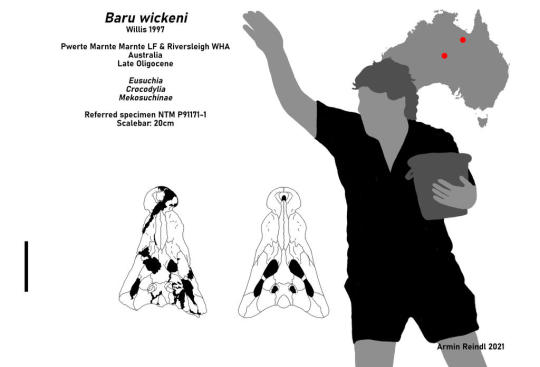
During the Miocene, Baru wickeni would be replaced by Baru darrowi, known from younger strata of the Riversleigh and the Bullock Creek fauna. Baru darrowi had less prominent crests, but in turn slight serrations on its teeth. Also the nasal bones did not extend into the nares. Baru darrowi is the species shown at the start.
The other two are then the unnamed Baru species from the Alcoota fossil site and "Baru" huberi. I talked about the latter before and how it is now thought to be something else entirely. Which leaves us with the Alcoota form. Generally regarded as a distinct species, fossils of the Alcoota Baru have been found from 2000 onwards near Alice Springs and appear to represent an animal more robust than the other known Baru. Below you can see a skeletal mount on exhibition at the Megafauna Central in Alice Springs (image by Aussie Bucket List) and a skull held by Adam Yates, an important researcher of this animal.
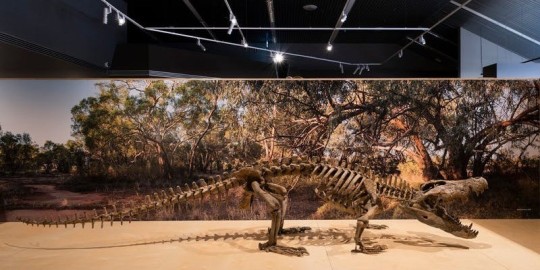
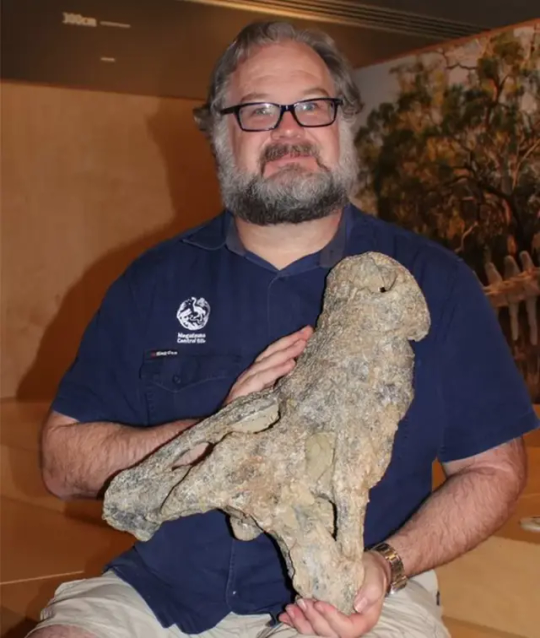
A little side note I want to mention is the name Baru. As you might have guessed from the etymology of various other mekosuchines (Kambara, Mekosuchus, Quinkana, Kalthifrons), the name actually ties into the native People of Australia. Specifically, Baru is a figure in the mythology of the East Arnhem Region, which describes him as a sort of totem crocodile that brought law to the lands he named. Baru also had a fight with Jarkitj (Willy Wagtail) after stealing fire for himself. Sadly I couldn't find much about the mythical Baru beyond a brief summary written up by George Pascoe Gaymarani you can read here.
Returning to the animal, one would suspect that the robust skull meant that it didn't quite hunt like modern crocodiles, especially considering the serrated teeth found in the younger species. Well, tho nothing concrete is known Willis and colleagues speculate that this might have been an adaptation to shallower waters. While modern crocs tend to ambush prey, grab it using a strong bite and conical teeth and then proceed to drown it, Baru may not have had that option. A modern croc can just drag a zebra for instance into deep water, weaken it and let go to adjust its grip without the risk of it getting away. In shallow waters, this may have been too risky and lead to prey escaping. So Baru's robust head and curved, sometimes serrated teeth were built to inflict a lot of damage upon prey when lunging, securing the bite and incapacitating it. Willis estimates that it may have taken prey as heavy as 300 kilos.
There's also the interesting tidbit of Baru wickeni coexisting with a diverse croc fauna, yet being conspicuously absent from more southern regions of Australia despite entering the respective drainage basin. I go into more detail while talking about Australosuchus, but the jist of it is that Baru was likely not as cold resistant as Australosuchus and thus not found as far north.
Alas, as with other mekosuchines, not much art of Baru exists aside from this absolutely fantastic piece by @knuppitalism-with-ue
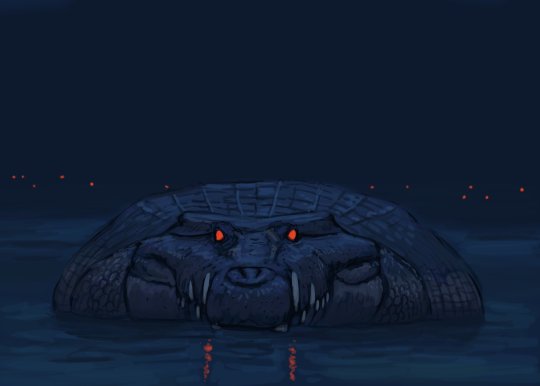
As per usual, this deep dive is brought to you as part of me redoing the wikipedia page of this genus, which resulted in a major size increase. The image below is just to show the difference, but if you want to read it here's the link: Baru - Wikipedia
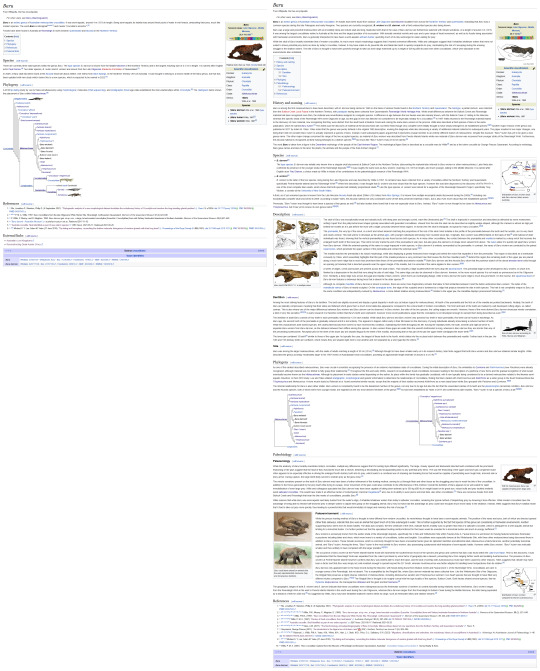
#mekosuchinae#wikipedia editing#wikipedia#baru#baru wickeni#baru darrowi#baru huberi#croc#crocodile#paleontology#palaeoblr#prehistory#oligocene#miocene#australia#long post
115 notes
·
View notes
Text
"Baru" huberi
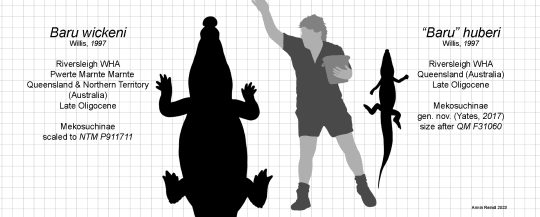
Baru is a genus of decently big mekosuchine crocodilian from the Oligocene and Miocene of Australia. The two currently accepted species, Baru wickeni and Baru darrowi, clock in between 4 to 5 meters, which puts them in a range not dissimilar to today's niles and salties.
But when Baru wickeni was named in 1997, a third species was also coined. Baru huberi, simply described as having been "much smaller"
Having started working on the wikipedia page for Baru recently, I did get curious to see how much smaller and well the results are....I mean "much smaller" seems like an understatement to me. Baru wickeni, which lived in the same area and at the same time as "Baru" huberi, dwarfed the other mekosuchine. Which brings us to "Baru" huberi's TRUE identity.
You see, tho named as a species of Baru, mekosuchine research has been mostly confied to the last 30 years and this paper came fairly early on in our understanding of the group, Naturally, things move around and change, as was the case for "Baru" huberi. Nowadays, researchers agree that "Baru" huberi is not a species of Baru. No, instead "Baru" huberi was a distinct genus seemingly more closely related to animals like Trilophosuchus or Mekosuchus and thus should get a new name.
That...obviously didn't happen yet but we'll get there eventually. Just gotta give it some more time. Meanwhile, I tried my hands at reconstructing the animal behind the name.

The grey area marks the big unknowns in "Baru" huberi, all the stuff we don't know. I based my interpretation primarily on Trilophosuchus, the best known member of this branch. On the left, you see the sympatric Baru wickeni. It's an older illustration of mine, but one that should mostly hold up.
Baru huberi - Wikipedia
The biochronology and palaeobiogeography of Baru (Crocodylia: Mekosuchinae) based on new specimens from the Northern Territory and Queensland, Australia [PeerJ]
New crocodilians from the late Oligocene White Hunter Site, Riversleigh, northwestern Queensland (biostor.org)
#baru#baru wickeni#baru huberi#“baru” huberi#mekosuchinae#oligocene#australia#croc#crocodile#crocodilia#herpetology#herpblr#palaeoblr#paleontology#prehistory#skeletal#pseudosuchia
93 notes
·
View notes
Text
Kambara
Here I go again with croc stuff. Back to dealing with stuff thats longer established, let me tell you about Kambara, the oldest named mekosuchine and a genus that surprised me with the bulk of information behind it.
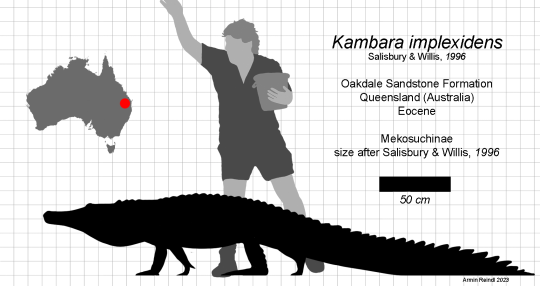
Kambara (which simply translates to "crocodile") is a genus of early mekosuchine that as of July 2023 contains four species, all from the Eocene of Queensland.
The first of these are Kambara murgonensis (Crocodile from Murgon) and Kambara implexidens (Interlocking Teeth Crocodile), both of which found at the same locality in Murgon, Queensland. The bones of both were in fact so intermingled that it was initially assumed that they represented a single species with highly variable anatomy, before the second species was recognized 3 years later.
There are a couple of differences between, but two are easiest to point out. For one, although being in the same size range (3-3.5 meters as adults), Kambara implexidens was a little more gracile. Furthermore, and the defining difference between them, K. implexidens (left) had interlocking teeth like a crocodile (bottom left), but K. murgonensis (right) had an overbite like an alligator (bottom right).

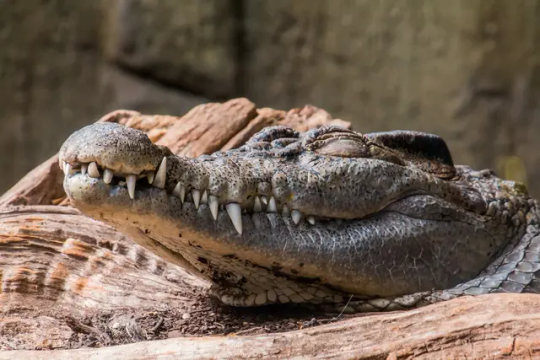

The next species named after these two was Kambara molnari (Molnar's Crocodile), but it's only known from much more limited material, the holotype being a lower jaw. Still some interesting information from this can be gathered. Which is that K. molnari seemingly represents an intermediate between interlocking dentition and an overbite. K. molnari wasn't found near Murgon, but in a different basin in Queensland, in the lower layers of the Rundle Formation.
Also from the Rundle Formation we have the most recently named and geologically youngest species, Kambara taraina (Crocodile Crocodile). Yeah the name is a bit redundant, but the logic of basing the species name on the Darumbal dialect as a proxy for language of the Bailai People is a nice one. Anyhow, K. taraina is a return to form as it is also known from good material like the first two, stemming from yet another large fossil bed possibly representing a mass death site. It had interlocking dentition like K. implexidens, BUT, unlike the oldest two species it did not coexist with the other Rundle Kambara. Instead, K. taraina came after K. molnari had presumably gone extinct.
Shown below the paratype of K. taraina, the holotype of K. implexidens and the holotype of K. molnari.

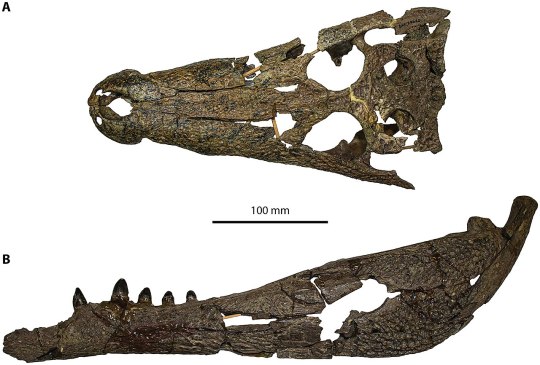
I won't get into phylogeny too much other than that its usually thought off as one of the earliest branching mekosuchines, but details vary. Lee and Yates found that Australosuchus may be more basal, while Ristevski et al. recover Kalthifrons as the earliest branch, in both cases Kambara is only the second branching.
There is one slightly odd alternative. Rio and Mannion do find it as the oldest branching mekosuchine....but also regard neither Quinkana nor Australosuchus as members of the clade...and further seemingly find "Asiatosuchus" germanicus to nest within Kambara? And then there's 2 out of the 8 trees by Ristevski, which show Kambara as a close relative to modern Crocodylids. But neither of those results match the current concensus and Rio and Mannion in general has a lot I disagree with.
Much more interesting is the postcrania and the implications for the lifestyle of Kambara. Now while we have a lot of bones from the rest of the body, given they were found in literal bonebeds, we don't know much about it. Crocodile fossils that aren't skulls are rarely described in detail. But there's still some information out there. Important here are Stein et al. 2012 and Buchanan's PhD thesis (which included the description of K. taraina, the one part that was formally published). Both looked at the postcrania and found that there are some differences to modern crocs. To keep things brief, while the anatomy is not nearly as derived as in a fully terrestrial croc, it does seem to suggest that Kambara would have had an easier time performing the crocodilian highwalk (shown below).
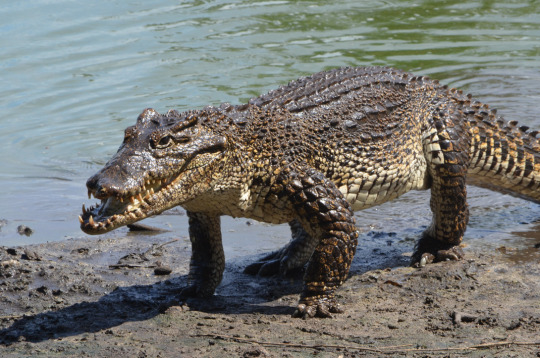
Again, this does not necessarily mean it lived on land, if anything the circumstances of the animals death seems to imply the opposite, but its still interesting. Buchanan suggests that this could have been used to walk through shallow water or bottom walking, and Stein et al. do point out that some adaptations of the limbs could also be advantages while swimming. The most important part to suggest that Kambara still lived in the water is the skull tho (well and it being found in freshwater habitats). The skull looks still remarkably like that of your generalist croc, somewhat flattened, nostrils on top, raised eyes, all that kind of stuff. So it presumably hunted like a modern croc and lived like a modern croc.
The exact lifestyle remains obscure tho. Again, generalist seems like the best supported hypothesis, but we don't know what kind of difference interlocking teeth and the overbite make. Theres some speculation of course. Mook for example proposed that an overbite functions like carnassial teeth in mammals, slicing and breaking, whereas interlocking dentition is better for gripping. While the difference in robustness between K. murgonensis and K. implexidens isn't that great, it could be suggested that the more robust species sliced and broke larger prey while the more gracile one dealt with slippery fish or struggling animals. Muscle attachments are also important, and those seem to show that the most recent species, Kambara taraina with interlocking teeth, had the greatest bite force and thus may have fed on larger prey than all its predecessors. But again, a lot of this requires further looking into.
We do have one singular piece of evidence for diet. The shell of a turtle from the Rundle Formation clearly bearing the tooth marks of Kambara. The bite marks show that the turtle was bitten multiple times, likely in an attempt to position it better in the mouth to bring it into position with the crushing back teeth or to swallow. Fun fact, this behavior is referred to as "juggling". But as you can see from the first figure, the Kambara in question was a bit cocky and picked a turtle way too large, eventually giving up. Sadly the turtle was very injured, and tho the wounds healed slightly, it eventually died from an infection.

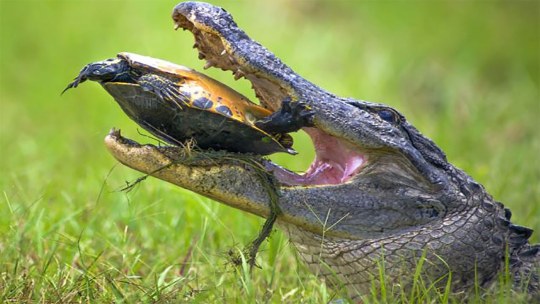
For the last section I briefly want to cover some last notes on Kambara murgonensis and Kambara implexidens, more specifically their coexistence. Now I covered the potential difference in hunting and prey preference already, but theres some other stuff to consider. For example, although found in the same locality, it is possible that this cohabitation was not the status quo. Given it is a mass death site at a locality that is known to have undergone wet and dry seasons, it is not unreasonable to assume that these animals died during a drought (another point against terrestrial life too, as they could have just left otherwise). Now even today crocs will gather in large groups in such situations, trying to make the most of dwindling water sources. This could mean that both species typically inhabited different biomes and only came together because they were forced to. The same might have also happend to Kambara taraina, causing increased aggression and explaining the many injured specimens found. Anyhow, it is also a possibility that they weren't divided by species, but by size, age and maturity. Buchanan points out that there are different habitat preferences between nesting females and juveniles, subadults and adult males in modern saltwater crocodiles. Big males prefer open water, nesting females areas with denser vegetation and subadults should avoid both as they threaten hatchlings and could be eaten by cannibalistic males. So that could also factor into the distribution of Kambara. And notably, it is pointed out that the Murgon site preserves both hachlings and egg shales, but seems to lack animals of intermediate size, which could suggest it was a nesting site.
Below a picture of an American Alligator and an American crocodile, simply because they remind me of Kambara and are an example of crocodilians that overlap in range, yet aren't super different like lets say Muggers and Gharials.
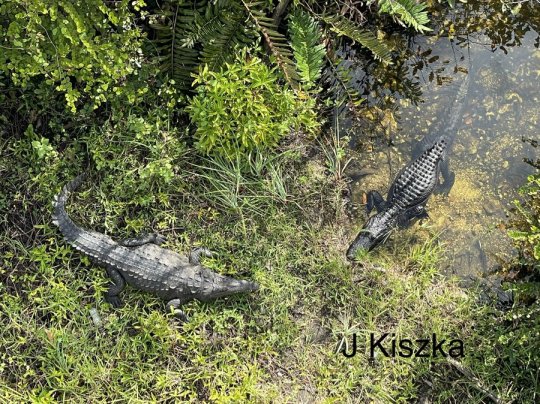
Alas Kambara suffers the mekosuchine curse, which is to say even with overwhelming material not much is actually published. Two bonebeds with all sorts of material, yet only 5 papers to its name, generally just accounting for the type description of each species + the humerus paper.
A lot of the info presented is actually from L.A. Buchanan's PhD thesis, which did include the description of Kambara taraina. However, since the completion of the thesis in 2008, only the description of the species was actually published. Entire chapters dealing with pathologies, postcrania and potential ecological inferrence are all are only present through the thesis, which has thankfully been uploaded in 2017.
Nevertheless, its a fascinating animal and I hope I made some people curious.
Wikipedia page:
Kambara - Wikipedia
#croc#crocodile#mekosuchinae#crocodilia#eocene#palaeoblr#prehistory#paleontology#long post#australia#skeletal#pseudosuchia#kambara#kambara implexidens#kambara murgonensis#kambara molnari#kambara taraina
75 notes
·
View notes
Text
Trilophosuchus
Happy to say that I wrapped up another deepdive into extinct crocs, this time with Trilophosuchus rackhami.
Not sure if I brought it up last time I talked about Mekosuchus, but Trilophosuchus is a pretty similar animal in many regards, being a dwarf species from the Cenozoic of Australia known from limited remains.

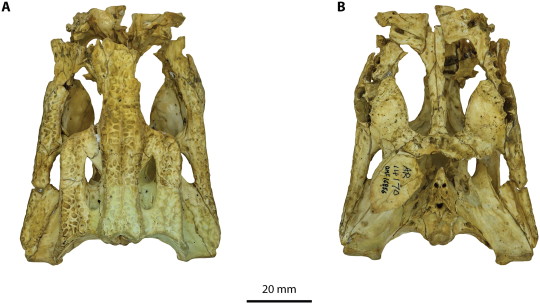
The difference being that Trilophosuchus, though not having hundreds of isolated bones, has 1 really complete skull with comparably minimal damage.
Based on this a lot can be determined already. It was very small (estimates suggest between 70 to 90cm for an adult), its skull was body and robust with big eyes and it had three unique crests that ran along its skulltable.
It's in fact so well preserved that scans revealed exceptional detail of the brain shape, more on that later.
Second photo by Jorgo Ristevski
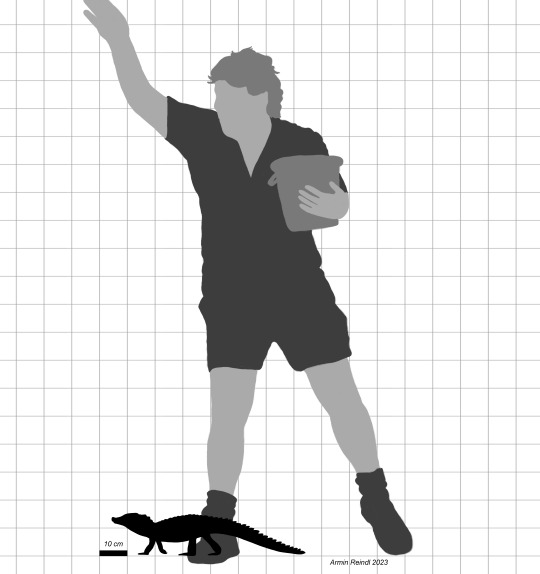
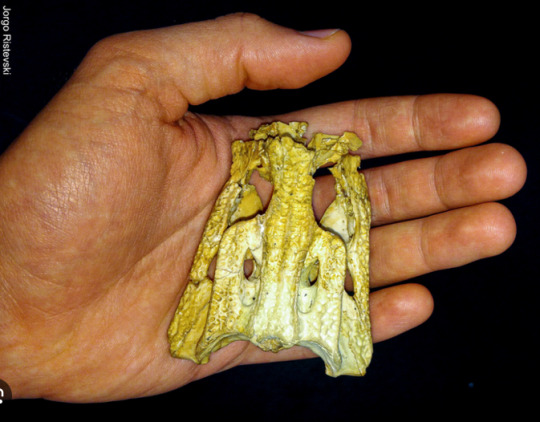
Where things get really interesting is the ecology and lifestyle. I mention it in the Mekosuchus post, but generally, these dwarf mekosuchines are assumed to have been more terrestrial than many of today's crocodiles. Their skulls in particular invite comparisson with today's dwarf crocodiles and dwarf caimans, rainforest dwellers that are not as water bound as the big, semi-aquatic ambush hunters. But Trilophosuchus takes this further, or at least it's thought that it did.
The muscule attachments around the skull for example indicate that Trilophosuchus naturally held its head decently high, which has been compared to the posture taken by modern caimans when basking. Furthermore, the muscles show clear differences in how it must have moved its head when feeding. Modern crocodiles have strong obliquus capitis magnus muscle, which are basically used in order to overcome water resistence when moving their heads side to side. Since this muscle is far less developed in Trilophosuchus, its reasonable to assume it didn't have to put up with water resistance as much. The muscles responsible for maintaining momentum once it starts shaking its head are well developed tho.

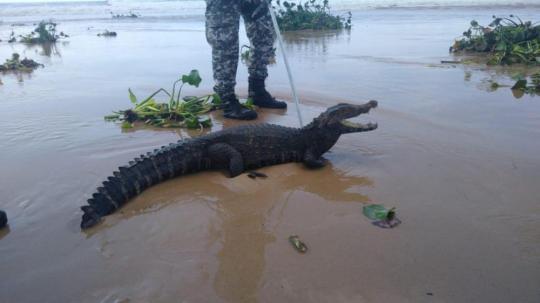
The brain is also of interest. The overall shape of the brain resembles that of the famous terrestrial notosuchian Araripesuchus, and the different elements of the brain can be compared to baurusuchids and sphenosuchians in their proportions. And finally, the skull is seemingly filled with air pockets, more than are seen in even todays dwarf crocodiles, though not quite as many as in notosuchians.
Trilophosuchus lived some 20 million years ago in Queensland, which at the time housed a highly diverse crocodile fauna. This included the large and robust Baru (tackling that one soon) which was a semi-aquatic ambush hunter, and the small Mekosuchus. There is still some mystery as to how these two dwarf species, both being relatively terrestrial, could have coexisted, but given we know very little still there is a myriad of possibilities.
Images by Willis, Murray and Megirian (1990) and Scanlon (2014)

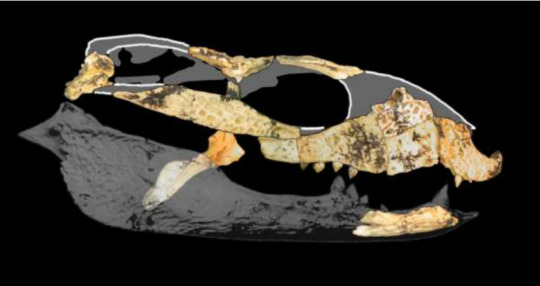
Something that needs to be pointed out tho, because this is still being believed by some. No, Trilophosuchus was NOT arboreal either. I go into the specifics of that for Mekosuchus on my Mekosuchus post, but the same applies for Trilophosuchus. Sorry, it's a bummer but it needed to be said.
Trilophosuchus definitely had a lot more written on it than many other things I covered before, but that doesn't mean it couldn't be built upon. Here the before and after as well as a link to the finished article.
Trilophosuchus - Wikipedia
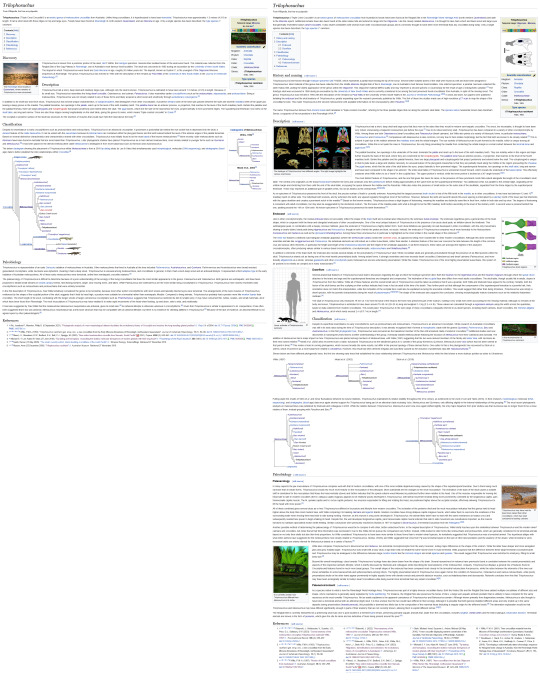
#palaeoblr#paleontology#crocodile#prehistory#wikipedia editing#long post#miocene#mekosuchinae#trilophosuchus#croc#paleo
58 notes
·
View notes
Text
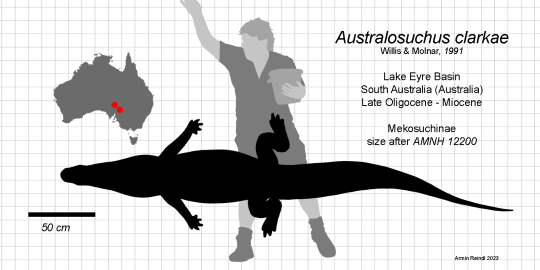
A comparably brief one this time, but this is Australosuchus. Australosuchus is yet another mekosuchine from the Oligocene to Miocene, roughly contemporary with "Baru" huberi from last time.
At around 3 meters long, its a medium-sized animal with a more or less generalist semi-aquatic bauplan known from plentiful remains all found in South Australia. And I do mean plentiful. We not only have many parts of the body, but plenty of specimens too.
Regarding its anatomy there's just one thing I wanna highlight which is the occlusal pit for the fourth dentary tooth. If you look at crocodile skulls, you'll often notice how the snout sorta constricts fairly early on. This is because the fourth tooth of the lower jaw neatly slides into this region. However, in Australosuchus this is less a notch or constriction, but a full on hole in the skull thats almost entirely enclosed. I just think thats neat.


Little is written about its biology, safe for one really fascinating thing. It's range. When looking at the fossil locality where the remains of this croc were found, you'll notice that it appears to be the only crocodilian around. By contrast, if you were to go to any locality in the north, like the famous Riversleigh WHA, you'll find a multitude of mekosuchine species of all shapes and sizes....yet no Australosuchus. For some time, it was suggested that there was simply a geographic barrier, a dessert perhaps. That the species in the north just couldn't reach the Lake Eyre Basin. But finds from Pwerte Marnte Marnte have shown that the northern forms, like Baru wickeni, were in fact present in the basin. So why not further south?
Well, Adam Yates suggests that latitude was the deciding factor. Yates argues that the species from the north like Baru were unable to handle the climate of southern Australia, which is why although present in the basin, Baru is not found anywhere below the 27° South. However, Australosuchus, which may have been more cold resistant (like modern alligators) was capable of surviving the lower temperatures, thus being the only crocodilian found in these southern waters during the Late Oligocene and Miocene. The whole thing is illustrated by Yates too for those who want a visual aid.
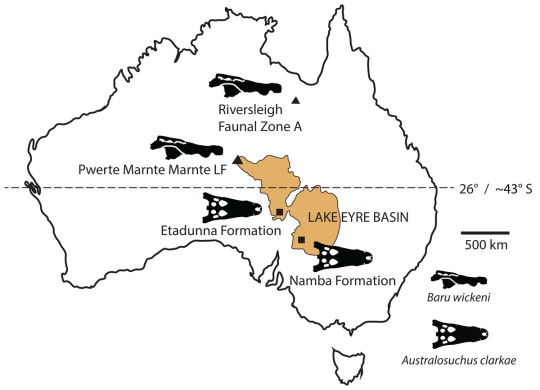
#mekosuchinae#australosuchus#baru#croc#crocodile#crocodilia#palaeoblr#paleontology#prehistory#herpetology#australia#oligocene#miocene
34 notes
·
View notes